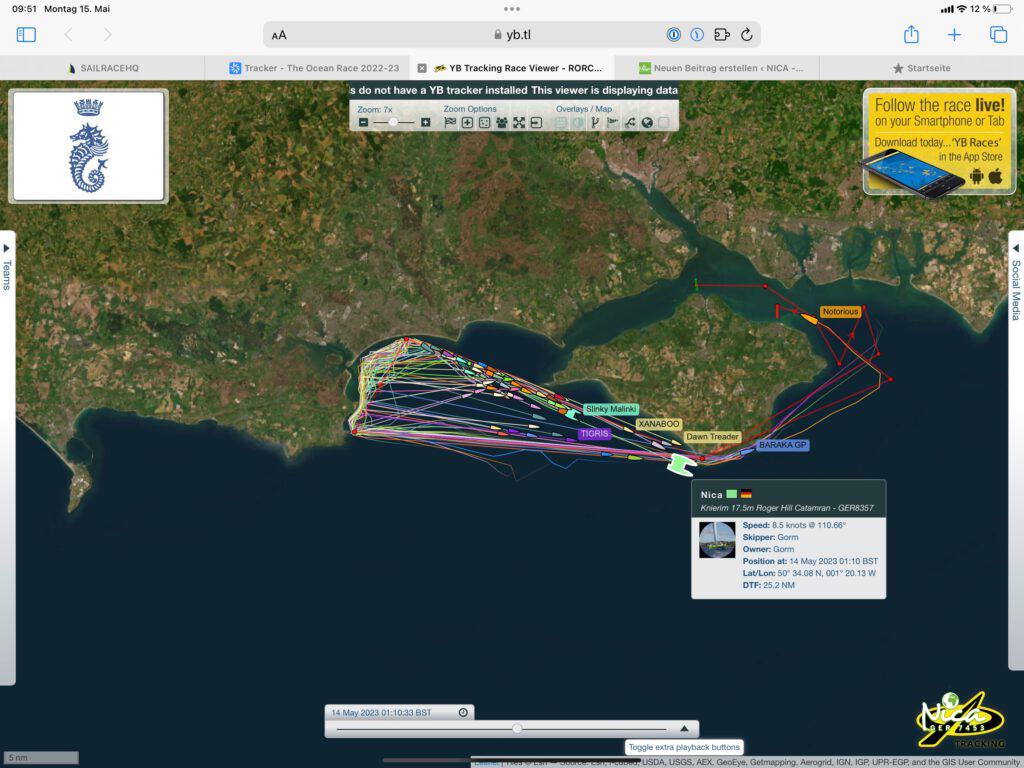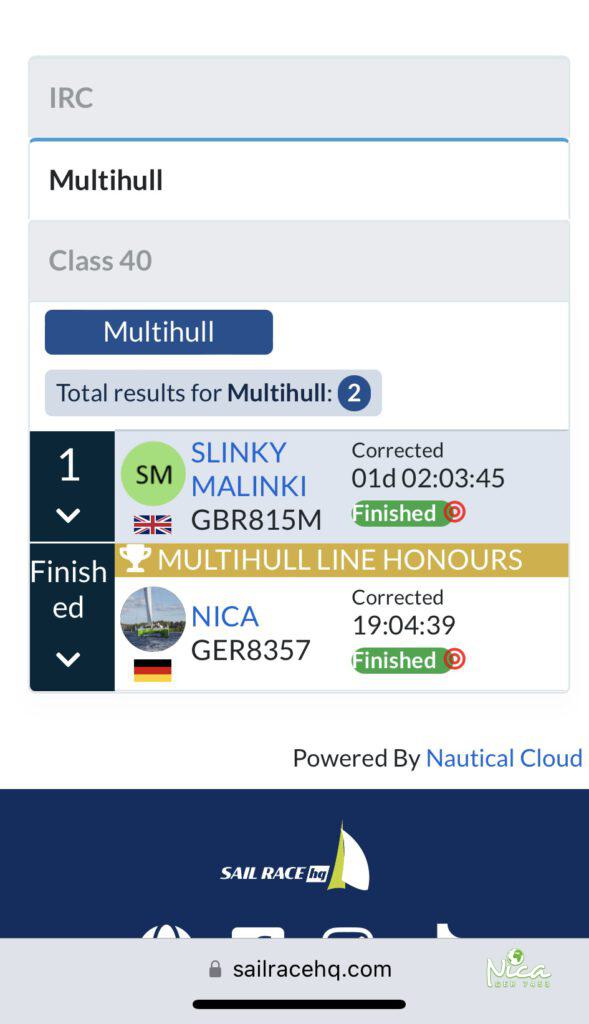English below.
Wir hatten eine tolle erste Offshore-Regatta mit unserem Katamaran Nica.
Mit 5 weiteren Mitseglern (Steffen Müller, Tim Kunze, Jesper Möller, Telse Beck, Felix Krause) ging es los. Eine relativ kleine Regattacrew für ein Schiff wie Nica, aber auf einer “Langstrecke” mit weniger Manövern geht das, auch wenn es viel Arbeit für die Crew bedeutet.
Die leichten Wetterbedingungen waren für die erste Regatta auf einem Katamaran günstig.
Der 112nm lange Kurs führte nach dem Start vor Cowes rechts südlich um die Isle of Wight nach Westen in die Poole Bay zum Peveril Point. Danach nördlich Richtung Poole und wieder südlich von der Isle of Wight zurück über den Osteingang des Solent nach Kemps Quay ins Ziel.

Wir starteten fast perfekt, nur 1-2 Sekunden später über die Linie und segelten bei 12kn Wind mit 12kn los. Leider waren wir so schnell, dass wir bei dem abflauenden Wind dann bei St. Catherines Point den Strom voll gegen an hatten und wir wenig Fortschritte machten, während die nachfolgenden Boote aufkamen. Das ist der Charme und die Herausforderung an der englischen Küste, die ich ja bereits öfter genossen habe.
Es zeigte sich auch, dass wir an der Kreuz noch nicht so gut klar kamen. Vielleicht lag es an den schlecht kalibrierten Instrumenten, weil wir den Mast gerade erst wieder aufgestellt hatten, aber sicher auch an unserer noch unzureichenden Segelzeit /Erfahrung mit Nica.
Die Polardaten für das Boot aus den VPP in den Ratings sind noch nicht wirklich brauchbar. Wir müssen hier eigene Erfahrungen machen, um aussagefähige Polardaten zu bekommen.
Das Sailchart für unsere Doyle Sails von Justin Ferris ist aber eine große Hilfe und schon sehr akkurat, obwohl es auch Theorie ist und erst jetzt mit mehr Leben gefüllt wird.
Nach der ersten Zwangspause bei St. Catherines Point ging es zunächst flott weiter mit 10-13kn Wind und Bootspeed zwischen 10-12kn. Aber dann wurde der Wind schwächer und ungleichmäßiger.
Am Peveril Point wurde es dann heftig. 4-6kn Wind und 2-2,5kn gegen an.
Dazu ist an der Tonne dort auch nicht viel Platz. Wir kämpften uns um die Tonne mit teilweise nur noch 0,5kn über Grund. Die folgende Kreuz verloren wir gegen die anwesenden Monohulls, nicht nur weil diese besser kreuzen können, sondern auch weil sie viel besser wenden können und unter Land mit weniger Strom short tacking betrieben.
Als wir nach gefühlt unendlichen Meilen oben in Pool an der Bahnmarke ankamen, gewannen wir wieder, weil wir die Windkante besser als die umliegenden Boote trafen und so schneller an die Bahnmarke kamen.
Der Wind kam jetzt wieder mit 8-12kn aus NNO und so ging es mit 10-12kn Richtung St. Catherines Point.
Kurz hinter den Needles schwächelte der Wind wieder und die Winddrehungen nahmen wieder bis 30° zu. Aber jetzt war die Tide mit uns, so dass wir gut weiterkamen. Bei 4-8 kn Wind und 40° Drehern ging es an der Kreuz Richtung Ost Solent.Die Strömung half. Aber wenn es für einen Monohull anstrengend ist, bei solchen Bedingungen zu kreuzen, dann ist es auf einem Kat unserer Art super herausfordernd zu kreuzen, weil ein Katamaran wenig Feedback gibt.
Um 6:24h waren wir dann nach 17 Stunden im Ziel, als 5. Boot von 87 Startern. Mit diesem Ergebnis sind wir für den Anfang sehr zufrieden.

Wir haben als Crew viel gelernt, verbessert und lernen das Schiff immer besser kennen.
Jetzt freuen wir uns auf ein paar Tage Cruisen in England und auch auf die nächste Wettfahrt in 14 Tagen, das ca. 230nm lange Myth of Malham Race.
De Guingand Bowl Race Report
We had a great first offshore regatta with our new Nica.
I started with 5 other sailors (Steffen Müller, Tim Kunze, Jesper Möller, Telse Beck, Felix Krause). A relatively small regatta crew for a ship like Nica, but it can be done on a „long distance“ with fewer maneuvers, even if it means a lot of work for the crew.
The light weather conditions were favorable for the first regatta and our little experience with the boat.
After starting off Cowes, the 110 nm long course led right around the Isle of Wight west into Poole Bay to Peveril Point and then north towards Poole and then south from the Isle of Wight back over the east entrance of the Solent to Kamps Quay Goal .
We started almost perfectly, just 1-2 seconds later over the line and set sail at 12kn in 12kn wind. Unfortunately we were so fast that when the wind died down we were fully against the current at St. Catherine’s Point and we made little progress while the following boats came up. That’s the charm and challenge of the English coast, which I’ve enjoyed before.
It also turned out that we didn’t get along so well on the upwind legs. Maybe it was the poorly calibrated instruments because we had just restepped the mast, but it was certainly also due to our insufficient sailing time/experience with Nica.
The polar data for the boat from the VPP in the ratings are not really usable yet. We have to make our own experiences here in order to get meaningful polar data.
The sail chart for our Doyle Sails by Justin Ferris is a great help and very accurate, although it is also theory and is only now being filled with more life.
After the first mandatory break at St. Catherines Point, the boat continued to sail with wind of 10-13 knots and a boat speed of between 10-12 knots. But then the wind weakened and became more uneven.
At Peveril Point it got violent. 4-6kn wind and 2-2.5kn against on.
There isn’t much space at the race mark for maneuvering due to shallow water and we made sometimes only 0.5 knots over the ground. We lost the following upwind leg against the monohulls present, not only because they sail better upwind, but also because they can tack much quicker and do short tacks on land with less current against them.
When we got to the mark after what felt like endless miles up Poolebay, we won again by hitting the edge of the wind better than the surrounding boats and getting to the mark more quickly.
The wind was now back at 8-12 knots from the NNE and went towards St. Catherine’s Point at 10-12 knots.
Shortly after the needles, the wind weakened again and the wind shifts increased again to up to 30°. But now the tide with us, so we made good progress. With 4-8 knots of wind and 40° shifts, we sailed upwind aiming for East Solent. The current was pushing us. But if it’s tough for a monohull to sail in those conditions, then it’s super challenging to sail on a cat of our kind because there is so little feedback from the boat.
At 6:24 a.m. we finished after 17 hours as the 5th boat of 87 starters. As catamaran beginners, we are very satisfied with this result.
As a crew, we have learned a lot, improved and are getting to know the ship better and better.
Now we are looking forward to a few days of cruising in England and also the next race in 14 days, the approx. 230 nautical miles long myth of the Malham race.

Test Kommentar